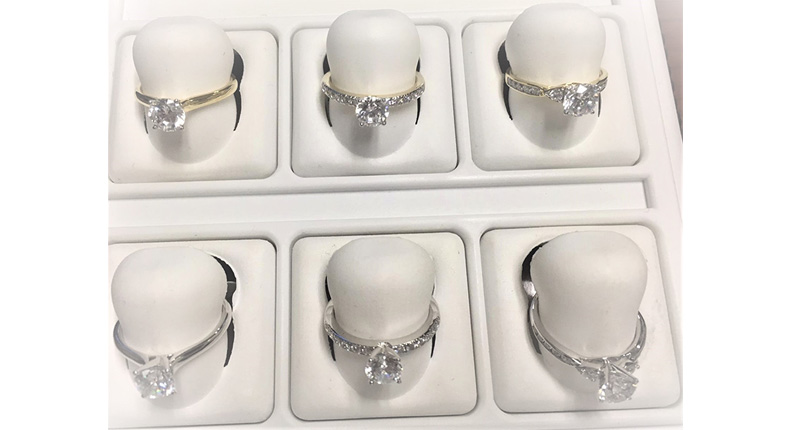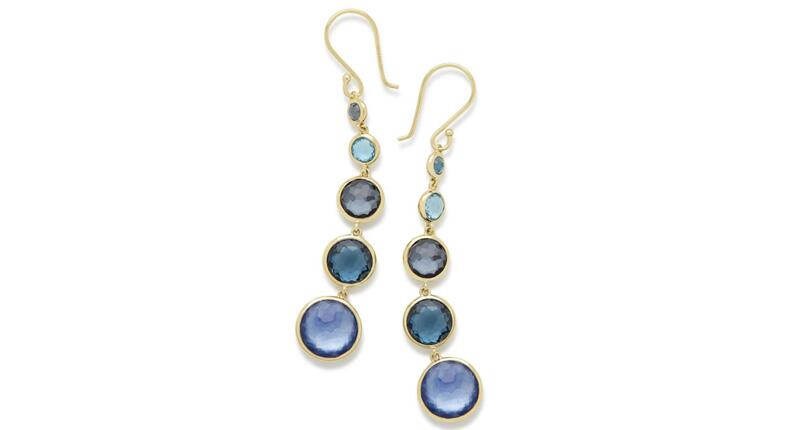The National Jeweler editors revisit the most noteworthy industry happenings and design trends from 2025.
These Rings Were Tracked Through Blockchain
The diamond engagement rings are the product of an initiative called TrustChain, the result of a collaboration between a group of jewelry companies and IBM.

The initiative, announced last week, is called TrustChain and is being launched with six gold and diamond engagement rings tracked via the IBM Blockchain Platform, which is delivered via the IBM Cloud.
Blockchains are digital ledgers that are decentralized, meaning they exist across multiple computers and servers; they’re not housed on any one computer or server, or owned by any one user or organization.
They are used by companies or groups of companies to record the history of transactions in a manner said to be more secure and allow for complete transparency. Transactions are recorded as individual “blocks” that are then “chained” together to show the complete record of transactions.
Each blockchain, whether it’s for UPS, Walmart or British Airways, is accessible only by permitted parties, and each block must be validated by the parties before it is added to the digital ledger.
De Beers is working with Boston Consulting Group on a blockchain initiative for tracing diamonds from mine to market, while Gübelin Gem Lab has partnered with Everledger to develop one for colored gemstones.
The TrustChain initiative, however, is the only one so far for a finished piece of jewelry with multiple components.
Mark Hanna, chief marketing officer for The Richline Group, which is manufacturing and distributing the initial TrustChain rings, said the initiative is important for the industry as it seeks to “raise the collective responsibility and provenance practices to new heights.”
The diamonds provided for the proof of concept came from Rio Tinto’s mines in Australia and Canada, and the gold from the Coeur Wharf Mine in South Dakota.
The raw gold was processed and refined at Asahi Refining in Salt Lake City, Utah, with LeachGarner transforming the gold bars into 14-karat white and yellow gold casting grain and sending it to Richline’s manufacturing facility in India.
The finished rings were returned to the United States via the Richline distribution center in Florida before being shipped to North Kansas City, Missouri-based Helzberg Diamonds. (Richline, LeachGarner and Helzberg are all owned by Berkshire Hathaway, Warren Buffett’s holding company.)
UL provided third-party verification of each transaction along the way.
Hanna said while they started with Canadian diamonds, U.S. gold and manufacturing at Richline’s facility in India for proof of concept, plans call for expansion of TrustChain in the future, incorporating more mines and manufacturers and making the jewelry available to additional retailers.
The Berkshire Hathaway companies, along with Asahi and UL, have been working with IBM on the TrustChain project since the beginning of 2017.
The TrustChain rings are set to go on sale at Helzberg in the fall, with the exact number of stores that will carry the rings still being determined.
Also still up in the air is how it will be marketed, packaged, presented in stores and explained by sales associates to the end consumer.

As far as pricing on the rings goes, Helzberg Diamonds Chief Merchandising Officer Julie Yoakum said the retailer “does not anticipate putting a premium on TrustChain product,” meaning that the rings tracked through blockchain are not expected to be more expensive for consumers than comparable pieces.
The FAQ section of the TrustChain website says when consumers buy a TrustChain ring, they will receive a “permanent digital record” of that ring’s journey through the supply chain. If that sounds like a familiar concept, it’s because Richline has done a program like TrustChain before.
More than a decade ago, Aurafin (and, later, Richline) worked with Walmart and Pam Mortensen, who then was heading the retailer’s fine jewelry department, to launch a line called “Love, Earth.”
Each person who bought a piece could go to a now-defunct website, LoveEarthInfo.com, to see on a map where the gold was mined and the piece was manufactured.
It was a pioneering program in jewelry traceability, predating the formation of the Responsible Jewellery Council, Forevermark’s launch in the United States and most certainly blockchain.
“This is how we (Richline) got to blockchain, from Love, Earth,” Hanna said, though he noted the technology used for Love, Earth back in 2006, called string, was much less sophisticated and more manual.
“We’re really going to be bringing back the program with a lot more documentation and a lot more touchpoints. The blockchain is kind of string on steroids.”
Hanna said from Richline’s perspective, there are additional costs involved in using blockchain in the short term, but the company anticipates those will be offset in the long term by the efficiencies it will create.
He also said he expects that in a year or two, the TrustChain initiative and the other blockchain pilots currently underway in the industry, from De Beers/Boston Consulting to Gübelin/Everledger, will be able to communicate and work together.
The Latest

Need a gift for the cat lover who has everything? Look no further than our latest Piece of the Week.

It purchased the “Grosse Pièce,” an ultra-complicated Audemars Piguet pocket watch from the ‘20s, for a record-breaking price at Sotheby’s.

How Jewelers of America’s 20 Under 40 are leading to ensure a brighter future for the jewelry industry.

The lab-grown diamond grower now offers custom engagement and fashion jewelry through its Kira Custom Lab Jewelry service.


Chandler got his start at Michelson Jewelers and has served as DCA president and CEO since 2001. He will retire at the end of the month.

The boutique is slated to open this week inside Terminal 8, offering pre-owned Rolex watches and more to international travelers.

Roseco’s 704-page catalog showcases new lab-grown diamonds, findings, tools & more—available in print or interactive digital editions.

Sponsored by Digital Monitoring Products

The special-edition egg pendant ingested in a New Zealand jewelry store was recovered after a six-day wait.

Associate Editor Natalie Francisco plays favorites with Piece of the Week, selecting a standout piece of jewelry from each month of 2025.

The “Love and Desire” campaign is inspired by the magic that follows when one’s heart leads the way, said the brand.

Two awardees will receive free tuition for an educational course at the Swiss lab, with flights and lodging included.

Berta de Pablos-Barbier will replace Alexander Lacik at the start of January, two months earlier than expected.

Sotheby’s held its first two jewelry sales at the Breuer building last week, and they totaled nearly $44 million.

Winners will receive free registration and lodging for its fourth annual event in Detroit.

Here are six ideas for making more engaging content for Instagram Reels and TikTok, courtesy of Duvall O’Steen and Jen Cullen Williams.

The honorees include a notable jewelry brand, an industry veteran, and an independent retailer.

Carlos Jose Hernandez and Joshua Zuazo were sentenced to life without the possibility of parole in the 2024 murder of Hussein “Sam” Murray.

Yood will serve alongside Eduard Stefanescu, the sustainability manager for C.Hafner, a precious metals refiner in Germany.

The New Orleans jeweler is also hosting pop-up jewelry boutiques in New York City and Dallas.

Set in a Tiffany & Co. necklace, it sold for $4.2 million, the highest price and price per carat paid for a Paraíba tourmaline at auction.

The jeweler’s “Deep Freeze” display showcases its iconic jewelry designs frozen in a vintage icebox.

Take luxury gifting to new heights this holiday season with the jeweler’s showstopping 12-carat sphene ring.

This year's theme is “Unveiling the Depths of the Ocean.”

In its annual report, Pinterest noted an increase in searches for brooches, heirloom jewelry, and ‘80s luxury.

Starting Jan. 1, customers can request the service for opal, peridot, and demantoid garnet.

























